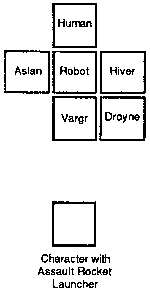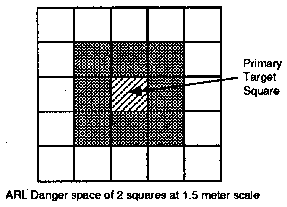
Traveller Q&A provides answers to questions from readers on various aspects of Traveller, MegaTraveller, and 2300AD. If you have a question you would like to have answered, send it to: Digest Group Publications, Q&A, 8979 Mandan Ct., Boise, ID 83709. We will publish the best of these questions and answers in this column. (Editor's Note: We especially need 2300AD questions. if you have any questions on 2300AD, by all means, send them in.)
Every single answer published in this column is seen and approved by Marc W. Miller, the leading designer of Traveller and 2300AD. We want to stress to our readers that anything appearing in Traveller Q&A is official unless explicitly stated to be a variant.
Are brownie points used only during character generation, or do they carry into play? - R. I.
Brownie points are a form of abstract "role-playing" to be used only during advanced character generation. We never intended them to be used after the character is generated. - Joe D. Fugate Sr.
Are player characters allowed to choose any weapon (like an FGMP-15) when they receive "weapon" as a mustering out benefit? - R. I.
Although not explicitly stated in the rules, the answer is hinted at on page 15 of the Players' Manual, under "Homeworld Limitations" as applied to weapon skills.
Player characters can choose any weapon that is not greater than their character's homeworld tech code, and is also within the homeworld's law code. Rogues, Pirates, and Law Enforcers can select weapons that are one law code lower than their homeworld. Nobles, who are not subject to any homeworld restriction, can select any weapon.
Remember that using a weapon without skill increases task difficulty by one level (see the Referee's Manual, page 15, under "Notes About DMs"). With the advent of the included skills (handgun, rifleman, and so on), player characters in MegaTraveller no longer have an automatic skill level-0 in all weapons. So even if you get an FGMP-15, you probably can't hit the broad side of a parked air/raft with it.
This easily takes care of many opportunities to select an FGMP-15. - Joe D. Fugate Sr.
Some weapons listed in MegaTraveller have a penetration of zero (0). Is this a mistake? - R. I.
A penetration of 0 is not a mistake. A character or animal with no armor has an armor value 0, and the minimum armor value for a craft/robot is 1. Also, because of the way range attenuation reduces penetration, the penetration value for many weapons reaches 0 at their extreme range - so the following comments also apply to them. See "Penetration and Damage" on page 70 of the Players' Manual.
A weapon with a penetration of 0 is only effective against unarmored characters or animals. In this case, the weapon penetration equals the target armor value (both are 0). By default, then, a successful hit gives a low penetration result, so the weapon inflicts 50% damage.
If the target has an armor value of 1+, a penetration 0 weapon rarely does any damage. In this case, the weapon gets a zero penetration result, giving just 10% damage.
What is perhaps not as obvious is what a weapon with a penetration value of 1 or more will do against a target with an armor value of 0. In this case, no matter what the weapon's penetration is, it always gets a high penetration result - which means it inflicts 100% damage.
Armed MegaTraveller combat is not a pleasant situation for unarmored targets. - Joe D. Fugate Sr.
The treatment of danger space, group hits, and autofire is confusing. The task roll to hit collateral/adjacent targets (or avoid being hit) is not defined in either the group hits or automatic weapons fire rules. - R. I.
Mixing and matching the additional direct fire rules can get a bit confusing at times. Throw in rapid fire, line of fire, and pinpoint hits, and a single fire attack may seem more like the attack of an entire squad.
If the rules seem unclear, just let common sense guide you; work through a combination attack in a methodical manner. As the referee, when faced with a potentially confusing combination fire attack, you'll save yourself a lot of headaches if you always, always, always determine a single primary target before you begin resolving any hits.
Once the single primary target has been identified in a combination attack, it remains the primary target for the entire combination attack. If the firing unit wants a shifting primary target, then he is conducting rapid fire instead.
Once the single primary target has been selected, resolve a combination attack by starting with automatic fire hits. Automatic fire weapons give the firing unit additional "bonus attacks". Roll a "to hit" task on the primary target as normal, then roll an identical "to hit" task for each adjacent target (players choice), up to the number of autofire targets possible. The firing unit has considerable freedom when specifying which adjacent targets - the attacking unit may actually apply all of its autofire attacks to the primary target if it wants to, as long as no other potential targets exist along the line of fire in the same range band. In any case, each autofire attack requires its own roll.
The line of fire rule also comes into play here. A good way to use the line of fire rule with autofire is to make the closest target in the line of fire the default primary target, with all other targets in the line of fire becoming adjacent targets. Any leftover autofire attacks (after applying at least one hit roll to each target in the line of fire) can be applied to laterally adjacent targets. In any event, leftover attacks should prefer the primary target for remaining unused attacks.
This leads us to a concept of "preferred target precedence." A preferred target should take more hits than any other target. The preferred target precedence for autofire targets is:
Danger space represents how much the weapon "splatters" or "sprays" when it hits; that is, what collateral damage the weapon does to nearby targets when it hits the primary target. These collateral hits are known as group hits. All units in a weapon's danger space are subject to group hits. Danger space is always expressed in meters.
To determine the danger space in squares, divide by the distance scale being used and round 0.5+ fractions up. The result indicates the number of squares (including the primary target square) to which the danger space extends. The danger space extends in all directions from the primary target square.
The example below illustrates how all of these concepts work together in a combination attack.
Example: In 1.5 meter scale combat, a character is firing an assault rocket launcher (ARL) with HE ammo at the group shown below:

The ARL has both autofire targets and a danger space. What do we do?
• Ask the player what he's shooting at (his preferred primary target), to determine the line of fire.
"The robot," replies the player.
• Check the line of fire. In this case, the Vargr and human are also in the line of fire. Logically, the closest unit becomes the default primary target, which in this case is the Vargr.
The player objects. "I'm shooting at the robot!"
• We require the player to roll exceptional success on his attack in order for the robot to be the primary target, since this violates the target precedence. Otherwise, he hits the Vargr as his primary target (line of fire).
The player gets exceptional success - he hit the robot as his primary target.
• The robot is now the primary target for the remainder of this autofire attack. The player still has two autofire targets left. He's hit the robot (the primary target) with an attack, so now the player rolls attacks on the adjacent targets in the line of fire, if he so desires. What does the player want?
"Another on the robot", replies the player.
• This is fine, since the robot is now the primary target. But the player still must roll exceptional success; otherwise, line of fire supercedes and he hits the Vargr instead.
The player misses the roll completely - he doesn't hit anything.
• The player has one last autofire hit roll left. What's his target?
"Last one on the robot", replies the player.
• Again, we state the player must get exceptional success, otherwise he hits the Vargr.
A hit - but not exceptional success. He hit the Vargr.
We evaluate the penetration for each and now apply damage. That takes care of the autofire hits. What about the danger space portion of the hits?
• The danger space of the ARL is 3 meters. Dividing by 1.5 meters, we get a danger space of 2 squares in all directions from the primary target square:

• The first autofire hit, as you recall, hit the robot.
Since each round explodes when it hits, also roll for a group hit (use the same "to hit" task we've been using all along) on the human, the Aslan, the Vargr, the Hiver, and the Droyne (all 1 square distant from the Robot). The penetration of any successful hit is halved (see the Players' Manual, page 73, "Group Hits").
• The last hit struck the Vargr, so we measure the danger space for group hits from the Vargr: This means we roll for a group hit at one-half penetration on the Aslan, the Robot, the Hiver, and the Droyne - which are all 1 square distant from the Vargr. Since the human is outside the two-square danger space centered on the Vargr; the human takes no hits.
I hope this explanation and example helps clear up your confusion. The keys are: use common sense to combine the various rules, and take it a step at a time. - Joe D. 'Fugate Sr.
The prices for the non-medicinal drugs are not given in the Imperial Encyclopedia. What are they? - R. I.
We neglected to include the non-medicinal drug prices. Here they are:
| Drug | Per Dose |
| Slow Drug | Cr500 |
| Medical Slow | Cr100 |
| Fast Drug | Cr200 |
| Combat Drug | Cr750 |
| Anagathics | Cr20,000 |
| Truth Drug | Cr5,000 |
| Slow Drug Antidote | Cr600 |
| Fast Drug Antidote | Cr900 |
If you have any pre-MegaTraveller rules set for Traveller, you will also find these drug prices listed there. - Joe D. Fugate Sr.